Saint-Germain-en-Laye
Saint-Germain-en-Laye (French: [sɛ̃.ʒɛʁmɛ̃.ɑ̃.lɛ] (![]()
Saint-Germain-en-Laye | |
|---|---|
Subprefecture and commune | |
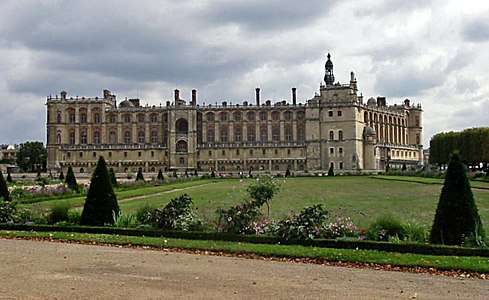 | |
 Coat of arms | |
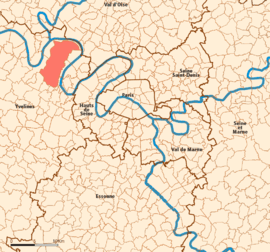 Location (in red) within Paris inner and outer suburbs | |
Location of Saint-Germain-en-Laye 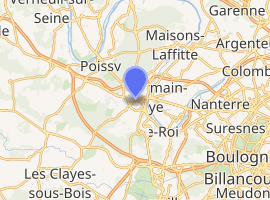
| |
 Saint-Germain-en-Laye Location (in red) within Paris inner and outer suburbs 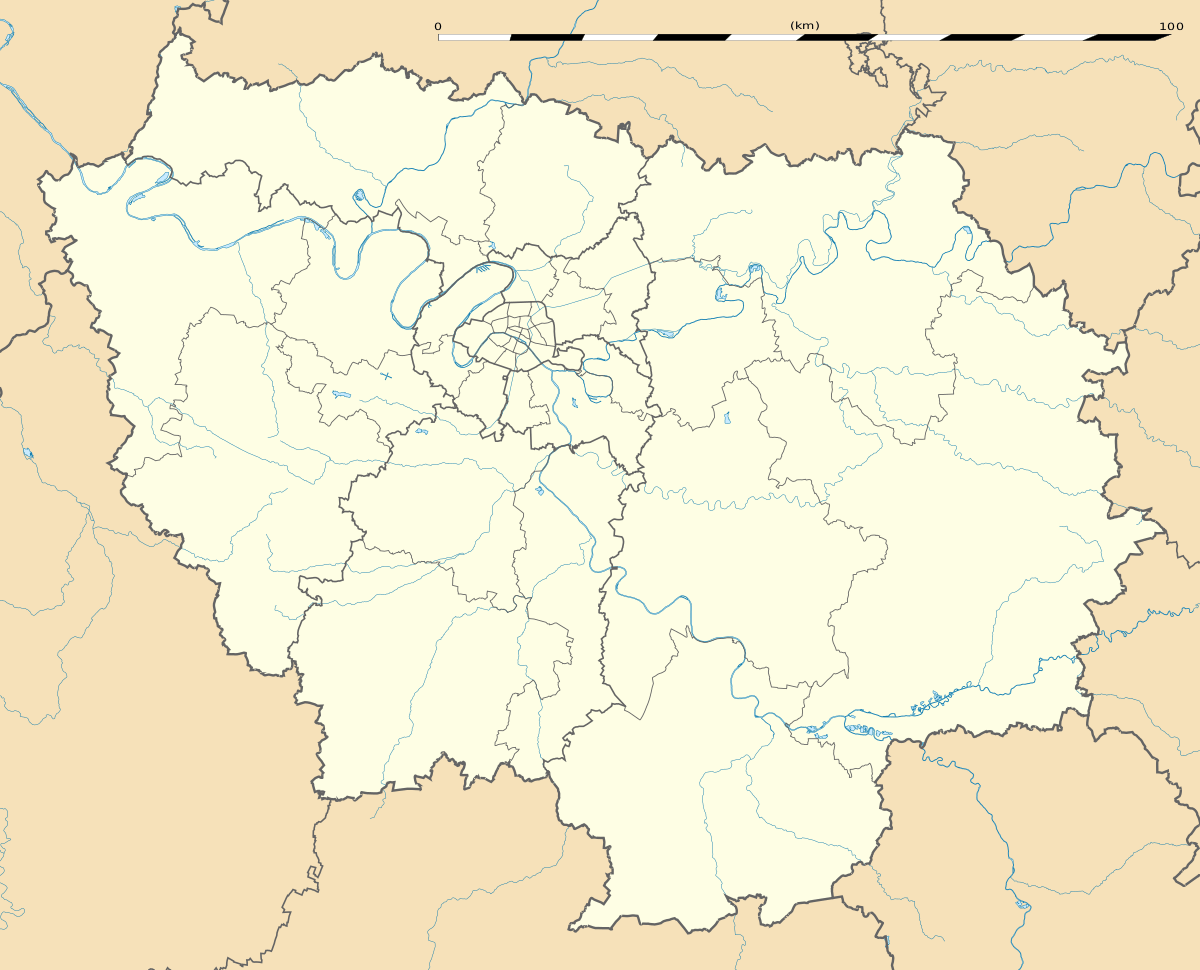 Saint-Germain-en-Laye Saint-Germain-en-Laye (Île-de-France (region)) | |
| Coordinates: 48°53′56″N 2°05′38″E | |
| Country | France |
| Region | Île-de-France |
| Department | Yvelines |
| Arrondissement | Saint-Germain-en-Laye |
| Canton | Saint-Germain-en-Laye |
| Intercommunality | CA Saint Germain Boucles Seine |
| Government | |
| • Mayor (2014–2020) | Arnaud Pericard |
| Area 1 | 51.94 km2 (20.05 sq mi) |
| Population (2017-01-01)[1] | 44,753 |
| • Density | 860/km2 (2,200/sq mi) |
| Demonym(s) | Saint-Germanois Saint-Germinois |
| Time zone | UTC+01:00 (CET) |
| • Summer (DST) | UTC+02:00 (CEST) |
| INSEE/Postal code | 78551 /78100 |
| Elevation | 22–107 m (72–351 ft) (avg. 78 m or 256 ft) |
| 1 French Land Register data, which excludes lakes, ponds, glaciers > 1 km2 (0.386 sq mi or 247 acres) and river estuaries. | |
Inhabitants are called Saint-Germanois or Saint-Germinois. With its elegant tree-lined streets it is one of the more affluent suburbs of Paris, combining both high-end leisure spots and exclusive residential neighborhoods (see the Golden Triangle of the Yvelines).
Saint-Germain-en-Laye is a sub-prefecture of the department. Because it includes the National Forest of Saint-Germain-en-Laye, it covers approximately 48 km2 (19 sq mi), making it the largest commune in the Yvelines. It occupies a large loop of the Seine. Saint-Germain-en-Laye lies at one of the western termini of Line A of the RER.
History
Saint-Germain-en-Laye was founded in 1020 when King Robert the Pious (ruled 996–1031) founded a convent on the site of the present Church of Saint-Germain.
In 1688, James II, King of England and VII of Scotland, exiled himself to the city after being deposed from the throne in what has become known as the Glorious Revolution. He spent the remainder of his days there, and died on 16 September 1701.[2]
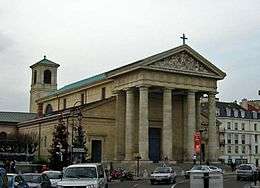
Prior to the French Revolution in 1789, it had been a royal town and the Château de Saint-Germain the residence of numerous French monarchs. The old château was constructed in 1348 by King Charles V on the foundations of an old castle (château-fort) dating from 1238 in the time of Saint Louis. Francis I was responsible for its subsequent restoration. In 1862, Napoleon III set up the Musée des Antiquités Nationales in the erstwhile royal château. This museum has exhibits ranging from Paleolithic to Celtic times. The "Dame de Brassempouy" sculpted on a mammoth's ivory tusk around 23,000 years ago is the most famous exhibit in the museum.
Kings Henry IV and Louis XIII left their mark on the town. Louis XIV was born in the château (the city's coat of arms consequently shows a cradle and the date of his birth), and established Saint-Germain-en-Laye as his principal residence from 1661 to 1681. Louis XIV turned over the château to James VII & II of Scotland and England after his exile from Britain after the Glorious Revolution in 1688. James lived in the Château for 13 years, and his daughter Louisa Maria Stuart was born in exile here in 1692. James II is buried in the Church of Saint-Germain.
Saint-Germain-en-Laye is famous for its 2.4-kilometre (1.5 mi) long stone terrace built by André Le Nôtre from 1669 to 1673. The terrace provides a view over the valley of the Seine and, in the distance, Paris. During the French Revolution, the name was changed along with many other places whose names held connotations of religion or royalty. Temporarily, Saint-Germain-en-Laye became Montagne-du-Bon-Air. During his reign, Napoleon I established his cavalry officers training school in the Château-Vieux.
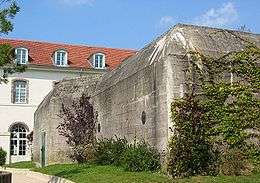
The Treaty of Saint-Germain was signed in 1919 and was applied on 16 July 1920. The treaty officially registered the breakup of the Habsburg empire, which recognized the independence of Czechoslovakia, Poland, Hungary, and the Kingdom of the Serbs, Croats, and Slovenes (Yugoslavia).[3]
During the occupation from 1940 to 1944, the town was the headquarters of the German Army .
On 1 January 2019, the former commune Fourqueux was merged into Saint-Germain-en-Laye.[4]
Transport
Saint Germain en Laye is connected to other communes by the Résalys bus network operated by Transdev Montesson-les-Rabeaux. Saint-Germain-en-Laye is served by Saint-Germain-en-Laye station on Paris RER line A.
It is also served by two stations on the Transilien Paris – Saint-Lazare suburban rail line: [[Saint-Germain – Bel-Air – Fourqueux (SNCF)|Saint-Germain – Bel-Air – Fourqueux] ] and Saint-Germain – Grande Ceinture.
Saint-Germain-en-Laye is also served by Achères – Grand Cormier station on Paris RER line A and on the Transilien Paris – Saint-Lazare suburban rail line. This station is located in the middle of the Forest of Saint-Germain-en-Laye, far away from the urbanized part of the commune.
Sport
Football

Saint-Germain-en-Laye has a proud footballing history. From 1904 to 1970 it was represented by Stade Saint-Germain which, following a 1970 merger with Paris FC, became Paris Saint-Germain (PSG). They are a top-flight football team who have won several French football cups and one C2 cup.[5] PSG are the highest ranking team in France.[6]
Sporting facilities
There is one main sporting facility in Saint-Germain-en-Laye: the Stade Municipal Georges Lefèvre. It covers over 12 hectares and contains: – 5 football pitches – 3 stands – 1 athletic track – 22 tennis courts – 1 clubhouse – 1 multibeach terrain [7]
Economy
Capcom Entertainment France, a Capcom subsidiary, has its head office in Saint-Germain-en-Laye.[8]
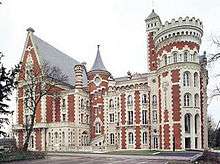
Education
As of 2016 the schools in this commune had 20,581 students, with 7,300 of them living in Saint-Germain-en-Laye. There is a high ratio of overall students to town inhabitants. The municipal nursery and primary schools have 3,549 students. 1,026 students attend private schools in the commune. 522 students attend the Lycée International de Saint Germain-en-Laye nursery and primary divisions.[9]
Schools
As of 2016 the municipality operates ten nursery schools and nine primary schools.[9]
The Lycée International de Saint Germain-en-Laye, a public school, is in Saint-Germain-en-Laye. It includes a section for Japanese students, and the Japanese Ministry of Education, Culture, Sports, Science and Technology (MEXT) lists that program in its group of European hoshuko (part-time Japanese educational programmes).[10]
Other public high schools:
- Lycée Jeanne-d'Albret
- Lycée technologique Léonard-de-Vinci
- Lycée technologique Jean-Baptiste-Poquelin
- lycée agricole et horticole de Saint-Germain-Chambourcy
Private schools include:
- Collège et Lycée Notre-Dame
- École Saint-Érembert
The Institut d'études politiques de Saint-Germain-en-Laye is also located in the city.
In art
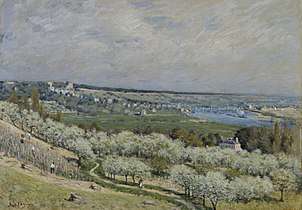 The Terrace at Saint-Germain, Spring, 1875 by Alfred Sisley. The Walters Art Museum.
The Terrace at Saint-Germain, Spring, 1875 by Alfred Sisley. The Walters Art Museum.
People
Saint-Germain-en-Laye was the birthplace of:
- Henry II (1519–1559), King of France
- Marie of France (1344–1404) Duchess of Bar
- Jeanne d'Albret (1528–1572), Queen Regnant of Navarre
- Charles IX (1550–1574), King of France
- Louis de Buade de Frontenac (1622–1698), French courtier and Governor of New France
- Louis XIV (1638–1715), King of France
- Philippe I, Duke of Orléans, (1640–1701), younger brother of Louis XIV
- Louisa Maria Teresa Stuart (1692–1712), daughter of James II of England, known to Jacobites as the Princess Royal
- John Patrick O'Gara (born 1692), a soldier in the Spanish Army of Jacobite Irish descent
- Charles O'Gara (1699–1777), a courtier and official of the Holy Roman Empire of Jacobite Irish descent
- Charles Gautier de Vinfrais (1704–1797), hunter and encyclopédiste
- Louis-Michel Letort de Lorville (1773–1815), French general of the Napoleonic Wars
- Jean Albert Gaudry (1827–1908), geologist and palaeontologist
- Salomon Reinach (1858–1932), archaeologist
- Claude Debussy (1862–1918), composer of European classical music
- Albert Alain (1880–1971), composer and organist
- Jaque Catelain (1897–1965), actor
- Jehan Alain (1911–1940), composer of European classical music
- Marie-Claire Alain (1926–2013), organist and organ teacher
- Jacques Fesch (1930–1957), christian mystic
- Jean-Jacques Lafaye (born 1958), writer, essayist
- Albert Dupontel (born 1964), actor
- Benoît Delbecq (born 1966), jazz pianist and composer
- Christian de Boisredon (born 1974), social entrepreneur
- Amélie Mauresmo (born 1979), tennis player
- Mélanie Thierry (born 1981), French actress
- Ismael Gace (born 1986), footballer
- Christopher Oualembo (born 1987), footballer
- Marion Maréchal-Le Pen (born 1989), French politician
- Jonathan Eysseric (born 1990), tennis player
- Caroline Garcia (born 1991), tennis player
- Rashad Muhammed (born 1993), footballer
The town is also associated with:
- James II of England, king who lived here in exile
- Charles-Hippolyte de Paravey, French engineer who died in the city
- Gérard de Nerval (1808–1855), poet, who lived there during part of his childhood and adolescence
- Gabriel de Mortillet (1821-1898) French archeologist and anthropologist, mayor of the town in 1882-1888
- Pierre de Porcaro (1904–1945), priest and prisoner-of-war during the Second World War
Twin towns - sister cities
Saint-Germain-en-Laye is twinned with:[12]


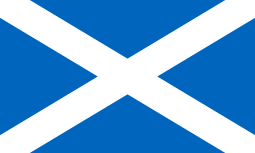


See also
- Communes of the Yvelines department
- The works of Antonin Mercié
References
- "Populations légales 2017". INSEE. Retrieved 6 January 2020.
- "James II (1633–1701)". BBC History. BBC. Retrieved 16 May 2020.
- Encyclopædia Britannica "Treaty of Saint-Germain", retrieved from Britannica.com.
- Arrêté préfectoral 19 December 2018 (in French)
- fr:Paris Saint-Germain Football Club#Depuis 2011 : l'ère Qatar Investment Authority
- "Site officiel du Paris Saint-Germain". FR.
- "Archived copy". Archived from the original on 21 June 2013. Retrieved 18 October 2012.CS1 maint: archived copy as title (link)
- "Contact." Capcom. Retrieved 12 August 2011. "France: Capcom Entertainment France 30 bis, rue du Viel Abreuvoir FR.78100 Saint Germain En Laye"
- "Children > Presentation." Saint-Germain-en-Laye. Retrieved 1 September 2016.
- "欧州の補習授業校一覧(平成25年4月15日現在)" (Archive). Ministry of Education, Culture, Sports, Science and Technology (MEXT). Retrieved 10 May 2014.
- "Home." Saint-Germain-en-Laye Libraries. Retrieved 1 September 2016.
- "Les villes jumelles". saintgermainenlaye.fr (in French). Saint-Germain-en-Laye. Retrieved 18 November 2019.